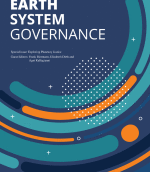Global governance consists of elementary regimes that form regime complexes, which in turn give rise to what we call superclusters around broad policy domains. In recent years, scholars have explored what these macroscopic structures look like and how they evolve over time. Yet the complex ways in which entire governance superclusters interact and coevolve, and what might emerge through this process, have not received much attention. In this article, we expand the ontological frontier of global governance research by offering a first bird’s-eye view on supercluster-level institutional interaction with an empirical focus on trade and environment. We constructed and analyzed a dynamic network-of-networks model, revealing a supercluster complex, a massive institutional structure in global governance consisting of two or more interlocking superclusters that exert a measurable influence on each other’s course of development. We theorize that the supercluster complex serves as an institutional fabric that enables the degree of self-organized coordination observed between the trade and environment policy domains. Our preliminary findings warrant more research on supercluster complexes as an important but little-noticed phenomenon in global governance.









